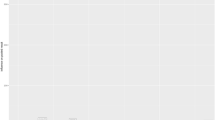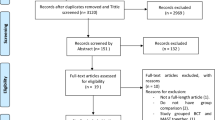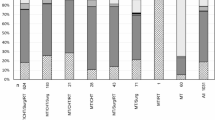Abstract
Background
The use of complementary and alternative medicine (CAM) has escalated over the past decade, despite the fact that clinical studies validating the efficacy of CAM remain sparse. Clinicians frequently encounter patients who reject standard treatment, but data on outcomes of patients choosing CAM as primary treatment for breast cancer are also lacking.
Materials and Methods
Breast cancer patients who refused/delayed standard treatments in favor of alternative therapies were identified in a community surgical practice over a 10-year period. A retrospective chart review was performed with telephone interviews when possible. Estimated 10-year survival given recommended treatment was calculated.
Results
A total of 61 patients was identified; median age was 53. Median follow-up was 54 months. Patients were stratified into 2 subgroups: those who omitted/delayed surgery (SSG, n = 26) and those who were nonadherent to adjuvant therapy recommendations (ASG, n = 35). In the SSG, 96.2% experienced disease progression; 50% died of disease. Mean stage at initial presentation was II; mean stage at re-presentation after primary treatment with alternative therapies was IV. Disease progression occurred in 86.2% of those in the ASG; 20% died of disease. The mean 10-year survival calculated for those omitting surgery was 69.5%; observed survival for this group was 36.4% at a median follow-up of 33 months.
Conclusions
Alternative therapies used as primary treatment for breast cancer are associated with disease progression and increased risk of recurrence and death. Diminished outcomes are more profound in those delaying/omitting surgery. Reviewing these results with our patients may help bridge the gap between CAM and standard treatments.



Similar content being viewed by others
References
Eisenberg DM, Davis RB, Ettner SL, Appel S, Wilkey S, Van Rompay M, et al. Trends in alternative medicine use in the United States, 1990–1997: results of a follow-up national survey. JAMA. 1998;280:1569–75.
DiGianni LM, Garber JE, Winer EP. Complementary and alternative medicine use among women with breast cancer. J Clin Oncol. 2002;20:34S–8S.
Morris KT, Johnson N, Homer L, Walts D. A comparison of complementary therapy use between breast cancer patients and patients with other primary tumor sites. Am J Surg. 2000;179:407–11.
Nahleh Z, Tabbara IA. Complementary and alternative medicine in breast cancer patients. Palliat Support Care. 2003;1:267–73.
Lengacher CA, Bennett MP, Kip KE, Keller R, LaVance MS, Smith LS, et al. Frequency of use of complementary and alternative medicine in women with breast cancer. Oncol Nurs Forum. 2002;29:1445–52.
Wyatt G, Sikorskii A, Wills CE, Su H. Complementary and alternative medicine use, spending, and quality of life in early stage breast cancer. Nurs Res. 2010;59:58–66.
Boon HS, Olatunde F, Zick SM. Trends in complementary/alternative medicine use by breast cancer survivors: comparing survey data from 1998 and 2005. BMC Womens Health. 2007;7:4.
Cui Y, Shu XO, Gao Y, Wen W, Ruan ZX, Jin F, et al. Use of complementary and alternative medicine by chinese women with breast cancer. Breast Cancer Res Treat. 2004;85:263–70.
Lee MM, Lin SS, Wrensch MR, Adler SR, Eisenberg D. Alternative therapies used by women with breast cancer in four ethnic populations. J Natl Cancer Inst. 2000;92:42–7.
Adams M, Jewell AP. The use of complementary and alternative medicine by cancer patients. Int Semin Surg Oncol. 2007;4:10.
Chen Z, Gu K, Zheng Y, Zheng W, Lu W, Shu XO. The use of complementary and alternative medicine among Chinese women with breast cancer. J Altern Complement Med. 2008;14:1049–55.
Greenlee H, Kwan ML, Ergas IJ, Sherman KJ, Krathwohl SE, Bonnell C, et al. Complementary and alternative therapy use before and after breast cancer diagnosis: the Pathways Study. Breast Cancer Res Treat. 2009;117:653–65.
Pedersen CG, Christensen S, Jensen AB, Zachariae R. Prevalence, socio-demographic and clinical predictors of post-diagnostic utilisation of different types of complementary and alternative medicine (CAM) in a nationwide cohort of Danish women treated for primary breast cancer. Eur J Cancer. 2009;45:3172–81.
Ernst E, Schmidt K, Baum M. Complementary/alternative therapies for the treatment of breast cancer. A systematic review of randomized clinical trials and a critique of current terminology. Breast J. 2006;12:526–30.
Jacobson JS, Workman SB, Kronenberg F. Research on complementary/alternative medicine for patients with breast cancer: a review of the biomedical literature. J Clin Oncol. 2000;18:668–83.
Ravdin PM, Siminoff LA, Davis GJ, Mercer MB, Hewlett J, Gerson N, et al. Computer program to assist in making decisions about adjuvant therapy for women with early breast cancer. J Clin Oncol. 2001;19:980–91.
Gerber B, Scholz C, Reimer T, Briese V, Janni W. Complementary and alternative therapeutic approaches in patients with early breast cancer: a systematic review. Breast Cancer Res Treat. 2006;95:199–209.
Acknowledgment
We thank the staff of Surgical Associates, in particular Trinh Nguyen, Andrea Vecht, and V. Winnie Kiser, for their assistance in the compilation of the data.
Author information
Authors and Affiliations
Corresponding author
Rights and permissions
About this article
Cite this article
Han, E., Johnson, N., DelaMelena, T. et al. Alternative Therapy Used as Primary Treatment for Breast Cancer Negatively Impacts Outcomes. Ann Surg Oncol 18, 912–916 (2011). https://doi.org/10.1245/s10434-010-1487-0
Received:
Published:
Issue Date:
DOI: https://doi.org/10.1245/s10434-010-1487-0




